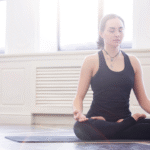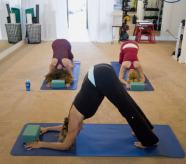If you’ve ever dealt with neck pain, you know just how much it can throw off your day and make life feel harder. Whether it’s from slouching at your desk, stress, an injury, or staring at screens for too long, neck pain is something millions of people struggle with. The good news? Yoga is a simple, natural way to help ease that discomfort. There are 14 specific yoga poses that work wonders for stretching and strengthening the neck, shoulders, and upper back—boosting flexibility and easing tension.
Common Causes of Neck Pain
Neck pain can come from different things—like bad posture (hello, desk slouching!), sleeping in a weird position, or injuries like whiplash from sudden movements. Degenerative issues like arthritis or herniated discs can also play a part. And let’s not forget stress, which tightens muscles and makes everything feel worse.
How Yoga Helps Relieve Neck Pain
Research shows yoga can be a great way to ease chronic neck pain. It mixes gentle stretching, strengthening, and relaxation techniques that target the neck, shoulders, and upper back—helping loosen tight muscles, boost flexibility, and improve movement. Regular practice increases blood flow, eases stiffness, and even helps posture. Plus, yoga teaches mindfulness, so you learn to release tension through slow, controlled movements and deep breathing.
Note: If you’ve had a recent injury, hold off on yoga until you’ve healed. Once you’re ready, a slow, gentle practice can bring real relief.
Best Yoga Poses for Neck Pain
Each of these poses is picked to ease tension, relax your body, and improve posture. Adding them to your routine can seriously cut down pain and boost overall well-being.
Important: Listen to your body, move at your own pace, and keep proper alignment. Skip anything that hurts, and if you’re unsure, check with a yoga instructor or doctor. If pain sticks around, see a professional for personalized care.
1. Cat-Cow Pose (Bitilasana Marjaryasana)
This flowing movement loosens tight back muscles and boosts spine flexibility. In Cat Pose, tuck your chin slightly to stretch the back of your neck. In Cow Pose, lift your head to open the front. The rhythm improves circulation and releases tension.
Pairing breath with movement makes it even more relaxing—inhale in Cow, exhale in Cat. It’s like a moving meditation that melts stress (a big neck-pain culprit).
2. Child’s Pose (Balasana)
A total relaxer for the neck and upper back. Let your thighs support you while your spine muscles unwind. For a deeper stretch, try:
- Arms by your sides (palms up) to round the shoulders and lengthen the neck.
- Arms overhead to stretch shoulders.
- Knees wide, one arm under hips, head turned to the side.
3. Standing Forward Fold (Uttanasana)
Let your head hang freely to release tension. For extra stretch, tuck your chin slightly. You can even gently shake your head side to side to loosen up.
4. Extended Puppy Pose (Uttana Shishosana)
Lengthens the spine and opens shoulders. Keep hips over knees as your chest sinks toward the floor. To deepen the stretch:
- Lift elbows while walking hands forward.
- Gently lower your chin to the floor.
5. Cobra Pose (Bhujangasana)
A gentle backbend that strengthens the spine and opens the chest. Lift your chest, lengthen your neck, and tilt your chin up to ease stiffness.
6. Thread the Needle (Sucirandhrasana)
A shoulder-opening twist that wrings out neck and shoulder tension. For a deeper stretch, reach the top arm overhead or wrap it behind your back.
7. Sphinx Pose (Salamba Bhujangasana)
Great for fixing poor-posture pain. Lift your chest, engage your core, and keep elbows under shoulders. Relax shoulders away from ears to avoid strain.
8. Bridge Pose (Setu Bandhasana)
Opens the chest, strengthens the back, and stretches the neck. Tuck your chin slightly to press the back of your neck into the floor.
9. Rabbit Pose (Sasangasana)
Stretches the whole spine, arms, and shoulders. Tuck your chin and draw shoulder blades down to deepen the stretch.
10. Supine Spinal Twist (Supta Matsyendrasana)
A gentle twist that eases spine tension. Keep shoulders grounded as you turn your head away from your legs. Boosts circulation and spinal health.
11. Cow Face Pose (Gomukhasana)
Deep stretch for shoulders and arms. One arm behind the back, the other overhead—keep your neck relaxed and spine tall.
12. Downward-Facing Dog (Adho Mukha Svanasana)
Lengthens the spine and decompresses the neck. Press palms down, slide shoulder blades back, and let your head hang freely.
13. Eagle Arms (Garudasana arms only)
Cross one arm under the other, palms together. Stretches shoulder blades—keep shoulders relaxed and elbows forward.
14. Camel Pose (Ustrasana)
Heart-opener that counters slouching. Arch back, reach for heels, and keep your neck long (no crunching!).
15. Fish Pose (Matsyasana)
Stretches chest and throat, relieving neck tension. Use a blanket under your head or a bolster under your upper back for support.
16. Lion Pose (Simhasana)
Fun way to release jaw and neck tension. Stick out your tongue, “roar,” and stretch your throat.
Practice Tips
- Warm up first: Roll shoulders, tilt head side to side.
- Breathe deep: Slow inhales/exhales help relax muscles.
- Don’t push it: Stay within your limits to avoid injury.
- Mind alignment: Keep neck and spine neutral.
- Use props: Blocks, straps, or blankets help.
- Try heat therapy: Warm towel or shower before yoga.
- Start slow: Build up gradually.
- Be consistent: Daily practice works best.
- Add meditation: Reduces stress, which worsens pain.
- Learn from pros: Videos or classes help with form.











